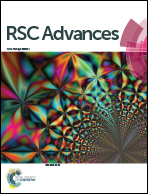A general route to modify diatomite with niobates for versatile applications of heavy metal removal†
Abstract
A general solution-phase strategy is developed to synthesize nanostructure niobates such as MnNb2O6, SnNb2O6 and ZnNb2O6 on natural mineral diatomite for water environmental remediation. (NH4)2C2O4 aqueous solution is the key to achieve a scalable and controllable synthesis of niobate/diatomite hybrid systems, which generates NH3·H2O for surface etching activation of diatomite, and H2C2O4 for complexation dissolution of Nb2O5, enabling the heterogeneous crystallization process to proceed with controllable growth kinetics. First principle calculations indicate that both niobium atom and niobium–oxygen species have the lowest adsorption energy on SiO2 surface, and then induce the nucleating process of Nb–O–Mn (or Zn, Sn) networks. Cr(VI), Fe(III), and Pb(II) ions are taken as target pollutants to evaluate the water-cleaning ability of the niobate-modified diatomite. Possible mechanisms for the photoreduction of Cr(VI), physical adsorption of Fe(OH)3 colloids, and chemisorption of Pb(II) ions are proposed on the basis of experimentally investigations. The possibility of combining the advantages of natural mineral diatomite and nanostructured niobates provides a highly robust and potential material system with versatile functionalities of heavy metal ion removal, demonstrating great promise for a wide range of water purification.



 Please wait while we load your content...
Please wait while we load your content...